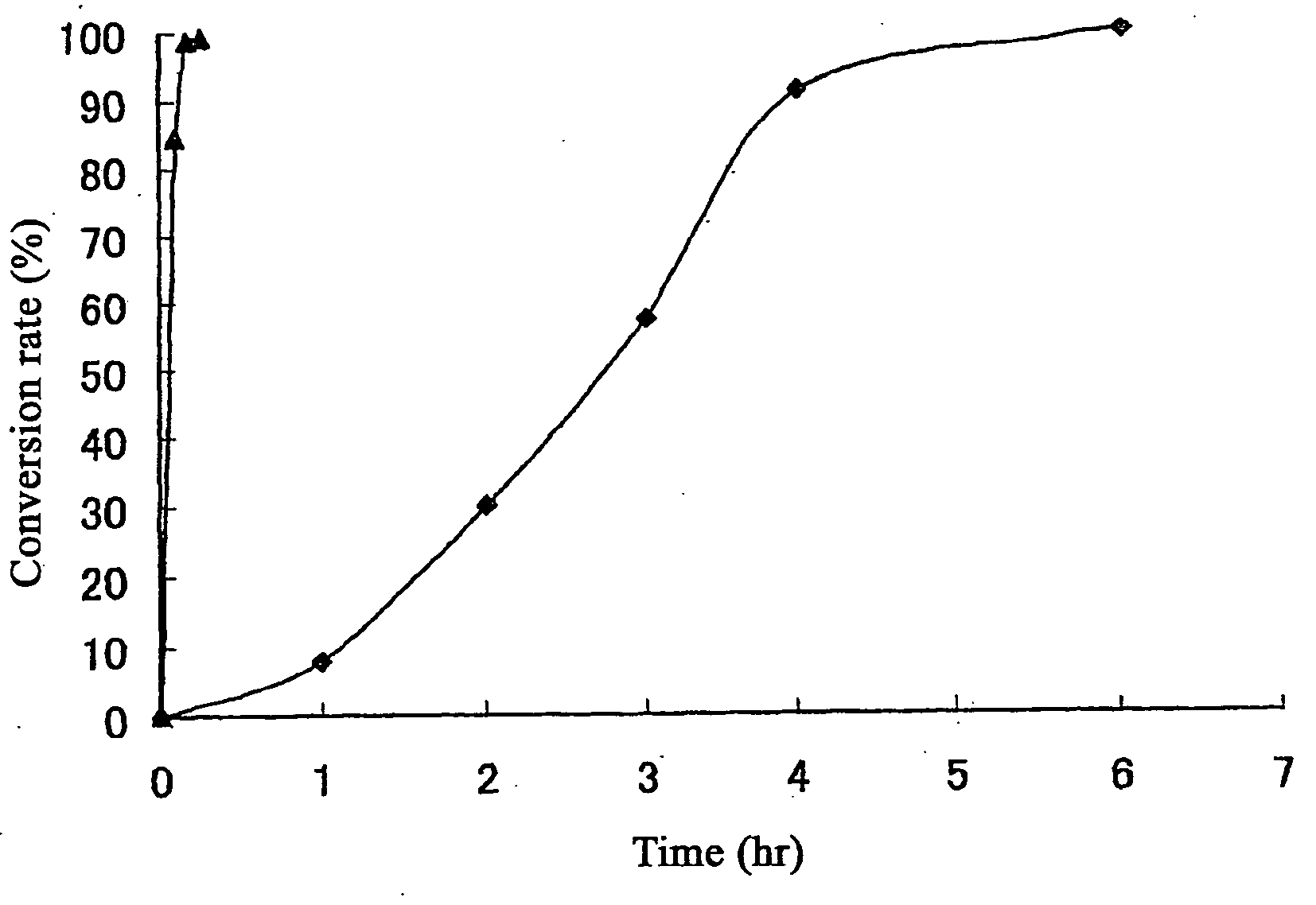Ruthenium complexes, process for preparation thereof, and processes for producing open-ring polymer of cycloolefins and hydrogenation products thereof by using the complex as catalyst
a technology of ruthenium complexes and complexes, which is applied in the field of ruthenium complexes, can solve the problems of ruthenium-carbene complex, unstable catalytically active species, and difficult control of metathesis reaction
- Summary
- Abstract
- Description
- Claims
- Application Information
AI Technical Summary
Benefits of technology
Problems solved by technology
Method used
Image
Examples
example 1
Preparation of (1,3-diisopropylhexahydropyrimidin-2-ylidene)(ethoxymethylene)(tricyclohexylphosphine) ruthenium dichloride
A Schlenk tube was charged with 2.8 parts of 1,3-diisopropyl-1,4,5,6-tetrahydropyrimidinium tetrafluoroborate (a product synthesized by the method described in Tetrahedron Letters., Vol. 32, No. 38, pp. 5031-5034, 1991) and 3 parts of sodium hydride. 130 parts of tetrahydrofuran (THF) and 240 parts of ammonia were added to the mixture. The mixture was stirred at reflux temperature of ammonia for three hours. The solvent was removed under reduced pressure to obtain a residue. 200 parts of n-hexane was added to the residue, and the mixture was sufficiently stirred. The solid component was removed by filtration to obtain a filtrate. The filtrate was added to a separately prepared solution of homogeneously mixed 1 part of bis(tricyclohexylphosphine)ethoxymethyleneruthenium dichloride (RuCl2 (═CH(OEt))(P(C6H11)3)2) and 130 parts of tetrahydrofuran, and the mixture ...
example 2
Preparation of (1,3-diisopropylhexahydropyrimidin-2-ylidene)(benzylidene)(tricyclohexylphosphine)ruthenium dichloride
A Schlenk tube was charged with 1.3 parts of 1,3-diisopropyl-1,4,5,6-tetrahydropyridinium tetrafluoroborate. Then, 23 parts of THF and 0.53 part of lithium diisopropylamide were added, and the mixture was stirred at room temperature for one hour. The reaction solution was filtered through celite. The filtrate was added to a separately prepared solution of homogeneously mixed 1 part of bis(tricyclohexylphosphine)benzylideneruthenium dichloride (RuCl2(═CHC6H5) (P(C6H11)3)2) and 45 parts of toluene, and the mixture was stirred at room temperature for one hour. The solvent was removed from the reaction solution under reduced pressure to obtain a residue. 41 parts of n-pentane was added to the residue, followed by removing the insoluble matter by filtration through celite. The filtrate was concentrated under reduced pressure to obtain a residue. The residue was dried un...
example 3
Preparation of (1,3-dimesitylhexahydropyrimidin-2-ylidene)(benzylidene)(tricyclohexylphosphine)ruthenium dichloride
A Schlenk tube was charged with 1 part of 1,3-dimesityl-1,4,5,6-tetrahydropyridinium tetrafluoroborate, 1 part of sodium hydride, and 0.1 part of potassium t-butoxide. 30 parts of THF was added to the mixture, followed by stirring the mixture at room temperature for three hours. The solvent was removed under reduced pressure to obtain a residue. The residue was extracted with 40 parts of n-hexane. The extract was then dried under reduced pressure. The extract was cooled to −78° C. and washed with n-pentane to obtain 0.3 part of a white solid. The white solid was mixed with 0.4 part of (pyridine)(tricyclohexylphosphine)benzylideneruthenium dichloride. 30 parts of THF was added to the mixture, followed by stirring the mixture for two hours. The reaction solvent was removed under reduced pressure to obtain a residue. The residue was washed with n-pentane and then recrys...
PUM
| Property | Measurement | Unit |
|---|---|---|
| Tg | aaaaa | aaaaa |
| Tg | aaaaa | aaaaa |
| catalytic activity | aaaaa | aaaaa |
Abstract
Description
Claims
Application Information
 Login to View More
Login to View More - R&D
- Intellectual Property
- Life Sciences
- Materials
- Tech Scout
- Unparalleled Data Quality
- Higher Quality Content
- 60% Fewer Hallucinations
Browse by: Latest US Patents, China's latest patents, Technical Efficacy Thesaurus, Application Domain, Technology Topic, Popular Technical Reports.
© 2025 PatSnap. All rights reserved.Legal|Privacy policy|Modern Slavery Act Transparency Statement|Sitemap|About US| Contact US: help@patsnap.com



